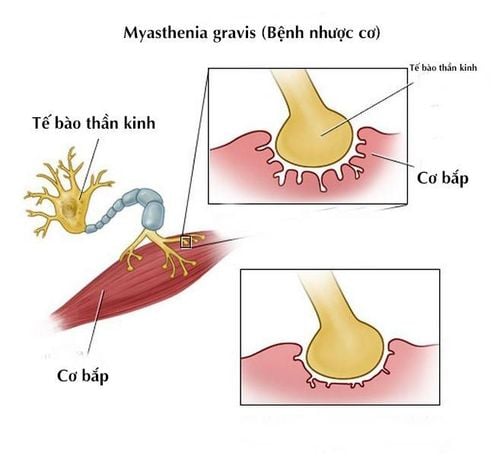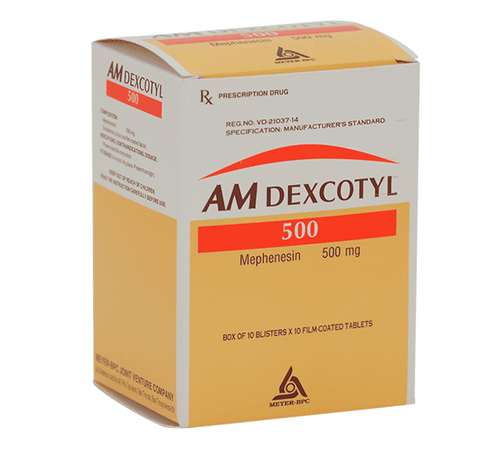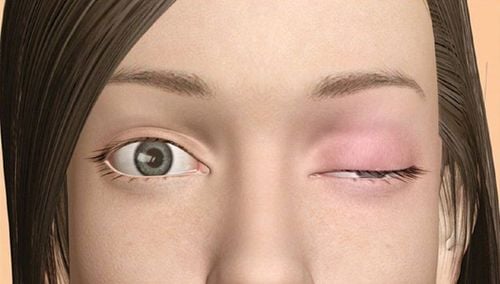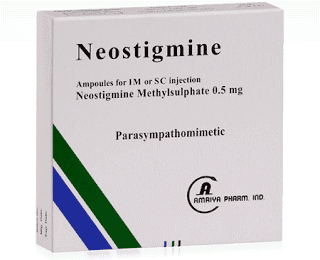This is an automatically translated article.
Myasthenia gravis is one of the neuromuscular-related autoimmune diseases with various characteristic symptoms. The primary cause was determined to be a loss of nerve-muscle communication, leading to decreased muscle tone.
1. What is myasthenia gravis?
Myasthenia gravis is a relatively rare autoimmune disease characterized by disturbances in neuromuscular transmission caused by immune system antibodies that attack the acetylcholine receptor (the receptor that acts as a transmitter). nerve) on the body's muscle cell membranes. This attack results in the muscles in the body not receiving enough nerve signals and becoming weak. Myasthenia gravis is common in both men and women, however, it is more common in women with a rate that is nearly twice that of men. It can occur at any age but is more common in women < 40 years old and men > 60 years old.2. Can myasthenia gravis be cured?
Although there is no drug that can treat myasthenia gravis, there are now remarkable achievements in the treatment of this disease. With current treatment methods, people with myasthenia gravis can lead almost normal lives like everyone else, their life expectancy is not reduced compared to others. However, you can be dependent on these drugs for many years or almost for the rest of your life, even though you run the risk of potentially dangerous side effects from the medications.
3. Treatment methods for myasthenia gravis

Bác sĩ thường phối hợp các phương pháp nội khoa và ngoại khoa để điều trị bệnh nhược cơ
In the treatment of myasthenia gravis, doctors often combine medical and surgical methods, depending on your condition.
3.1. Medical treatment Currently, there is no medicine to treat myasthenia gravis. The drugs used only work to reduce the diagnostic symptoms of myasthenia gravis, inhibit the progression of the disease but do not cure the root of the disease. Some drugs are prescribed by doctors to treat myasthenia gravis as follows:
Cholinesterase enzyme inhibitors (pyridostigmin, neostigmin), which inhibit the activity of cholinesterase enzymes, which play a role in breaking down acetylcholine in the brain . Therefore, the drug increases the concentration of acetylcholine, so it enhances nerve conduction to the muscles, helping the muscles to improve strength. On the other hand, there was no reduction in the number of postsynaptic neuromuscular junction receptors. However, the drug is only effective in the initial treatment of mild myasthenia gravis or newly diagnosed myasthenia gravis. However, when patients use this drug, it can cause unwanted side effects such as: muscle cramps, loss of appetite, diarrhea, nausea... Immunosuppressive drugs (corticosteroids, azathioprine). , methotrexate...) this is a method of using immunosuppressive drugs to inhibit autoimmune activity at the neuromuscular synaptic cleft. Corticosteroids or non-steroidal drugs are a group of drugs used in the treatment of myasthenia gravis. These drugs also have side effects such as nausea, stomach ulcers, increased risk of infection, liver damage, etc. kidney. Group of monoclonal antibodies g: Rituximab is a group of monoclonal antibodies that weaken white blood cells, change the immune system, so it is often used to improve symptoms of myasthenia gravis. However, the side effects of Rituximab are headache, fever, chills, vomiting, gastritis... Most of the drugs used in the treatment of myasthenia gravis are prescription drugs and can cause side effects. dangerous side effects, so patients need to strictly follow the doctor's instructions, avoid arbitrarily use causing unwanted side effects.
Besides using drugs to treat myasthenia gravis, patients need to rest, maintain a reasonable diet, avoid stress, etc. to help relieve the symptoms of myasthenia gravis effectively.
3.2. Surgical treatment Thymus surgery: People with myasthenia gravis experience abnormal thymus symptoms, so surgical removal of the thymus is also a treatment for myasthenia gravis. The results of the treatment of myasthenia gravis by this method are relatively positive, but the postoperative treatment is the opposite, so the surgery needs to be performed in experienced and well-resuscitated facilities. After surgery, patients with myasthenia gravis continued to be treated with medium-dose prednisolone. Plasmapheresis: The treatment of myasthenia gravis has the effect of filtering anti-receptor antibodies as well as complement components in the plasma, severe symptoms of myasthenia gravis will be relieved. In a sense, this can also be considered an immunosuppressive method. In addition to the above methods, the doctor may also use short-term treatment methods for myasthenia gravis such as immunoglobulin infusion or plasma exchange (if myasthenia gravis is worsening, severe, and treat myasthenia gravis). muscle before thymic surgery) when myasthenic symptoms are not well controlled. These two short-term treatments for myasthenia gravis give very good results, but no long-term effects.
4. How long does myasthenia gravis live?

Hiện nay chưa có phương pháp điều trị dứt điểm bệnh nhược cơ
Myasthenia gravis is a neuromuscular disease associated with autoimmune in the body. The disease has not yet found a cure for myasthenia gravis completely. To ensure your health, when you have been diagnosed with a disease, you should note:
Make a daily plan to keep your health in the best way; All drugs to treat myasthenia gravis have side effects, when using the drug for a long time, it is necessary to pay attention and strictly follow the instructions of the treating doctor to limit those side effects; Avoid overwork and unnecessary fatigue; Avoid excessive stress or emotions; Avoid exposing the body to infections (eg, avoid crowds, avoid colds); Avoid drugs that directly affect neuromuscular transmission, such as aminoglycoside antibiotics (eg, gentamicin), ketolides (eg, telithromycin). It should be noted that an overdose of an anticholinesterase drug such as pyridostigmine or neostigmine can increase muscle weakness or even cause cholinergic disorders (increased salivation, tears, perspiration or vomiting).
Although there is no cure, you can still live with myasthenia gravis for many decades, but you must have a proper diet, work, and activities and do not delay treatment. If you find yourself showing signs of myasthenia gravis, you need to go to the hospital soon for a specific examination by doctors, to avoid the progression of the disease causing unfortunate consequences.
Vinmec International General Hospital currently has modern methods of diagnosing myasthenia gravis, performed by a team of highly qualified and experienced medical doctors, with a complete and advanced medical equipment system that will for accurate diagnosis of myasthenia gravis.
For detailed advice on methods of diagnosing myasthenia gravis at Vinmec, please come directly to the Vinmec health system or register for an online examination HERE.
MORE:
Mechanism of formation of myasthenia gravis (myasthenia gravis) How dangerous is myasthenia gravis in children? Dangerous complications of myasthenia gravis













